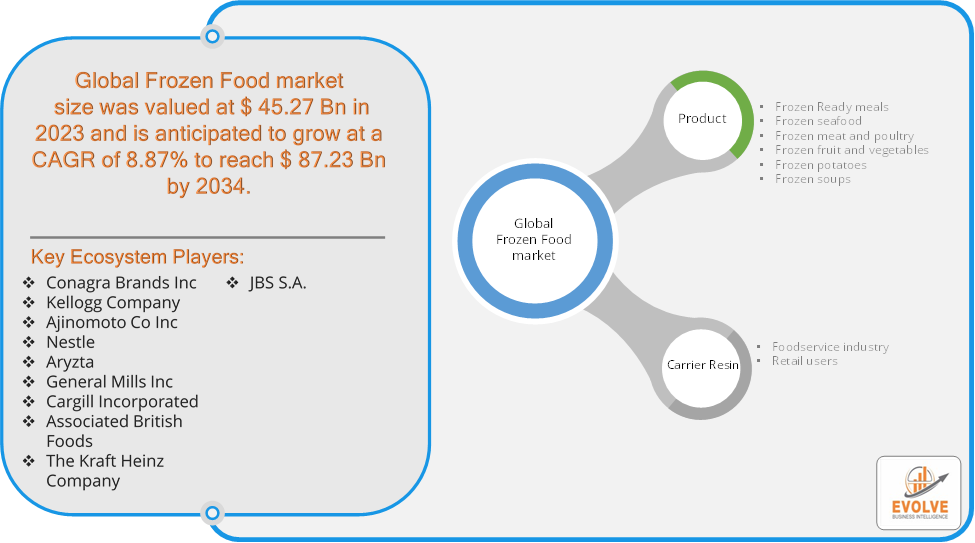Evolve Business Intelligence has published a research report on the Global Frozen Food Market, 2021–2034. The global Frozen Food market is projected to exhibit a CAGR of around 4.41%during the forecast period of 2021 to 2034.
Evolve Business Intelligence has recognized the following companies as the key players in the global Frozen Food Market: Conagra Brands Inc, Kellogg Company, Ajinomoto Co Inc, Nestle, Aryzta, General Mills Inc, Cargill Incorporated, Associated British Foods, The Kraft Heinz Company, JBS S.A..
 More Information: https://evolvebi.com/report/frozen-food-market-analysis/
More Information: https://evolvebi.com/report/frozen-food-market-analysis/
Market Highlights
The Frozen Food Market size accounted for USD 45.27 Billion in 2023 and is estimated to account for 49.78 Billion in 2024. The Market is expected to reach USD 87.23 Billion by 2034 growing at a compound annual growth rate (CAGR) of 8.87% from 2024 to 2034. Frozen food refers to food products that have been preserved through the process of freezing, wherein the food is subjected to extremely low temperatures, typically below 0 degrees Celsius (32 degrees Fahrenheit), to maintain its quality, nutritional value, and sensory attributes for an extended period. This preservation technique inhibits the growth of microorganisms and enzymatic activity, thereby slowing down the deterioration of the food. Frozen food encompasses a wide range of products, including raw ingredients, pre-cooked meals, snacks, desserts, and fully prepared dishes, which are typically packaged in airtight containers or bags to prevent freezer burn and maintain product integrity. The frozen food industry is characterized by its convenience, extended shelf life, and diverse product offerings catering to consumer preferences and needs.
Segmental Analysis
The global Frozen Food market has been segmented based on Product Type, End User
Based on Product Type, the market is segmented based on Frozen Ready meals, Frozen seafood, Frozen meat and poultry, Frozen fruit and vegetables, Frozen potatoes, and Frozen soups. The Frozen Ready Meals segment is expected to witness significant growth during the forecast period. This growth can be attributed to several factors. the increasing pace of modern lifestyles and busy work schedules has led to a growing demand for convenient and time-saving meal solutions. Frozen Ready Meals offer a quick and hassle-free option for individuals and families seeking ready-to-eat or easy-to-prepare meals without compromising on taste and quality. Additionally, the advancements in freezing and packaging technologies have significantly improved the quality and variety of frozen-ready meals available in the market, appealing to a wider consumer base.
Based on End Users, the market has been divided into the Foodservice industry, Retail users. The food service industry dominates the Frozen Food Market. This sector encompasses restaurants, cafes, hotels, catering services, and other establishments that provide prepared meals to consumers. The demand for frozen food from the food service industry is driven by various factors, including the need for convenient and time-efficient food preparation, cost-effectiveness, and the ability to offer a wide range of menu options. Frozen food allows food service providers to streamline their operations, reduce food waste, and ensure consistent quality and taste.
More Information: https://evolvebi.com/report/frozen-food-market-analysis/
Regional Analysis
The Frozen Food market is divided into five regions: North America, Europe, Asia-Pacific, South America, and the Middle East, &Africa. North America holds a dominant position in the Frozen Food Market. The region’s dominance can be attributed to various factors. The busy lifestyles of consumers in North America have led to high demand for convenient and time-saving food options, making frozen food a popular choice. Additionally, the well-developed infrastructure and distribution networks in the region ensure the widespread availability of frozen food products across retail channels. Furthermore, North America has a mature food service industry, with a high prevalence of restaurants, fast-food chains, and other food service establishments that heavily rely on frozen food for their operations. The region also has a strong culture of frozen food consumption, with a wide variety of products catering to different tastes and dietary preferences. The Asia-Pacific region has indeed emerged as the fastest-growing market for the Frozen Food industry. Several factors have contributed to this growth. Rapid urbanization and changing lifestyles in countries such as China, India, Japan, and South Korea have led to an increased demand for convenient and time-saving food options, including frozen food. As more people join the workforce and face time constraints, the need for quick and easy meal solutions has driven the growth of the frozen food market in the region. Additionally, rising disposable incomes and expanding middle-class populations have led to changes in dietary habits, with consumers seeking a greater variety of food choices, including frozen food products. Furthermore, the advancements in freezing technologies and cold chain infrastructure have improved the quality and accessibility of frozen food in the region.